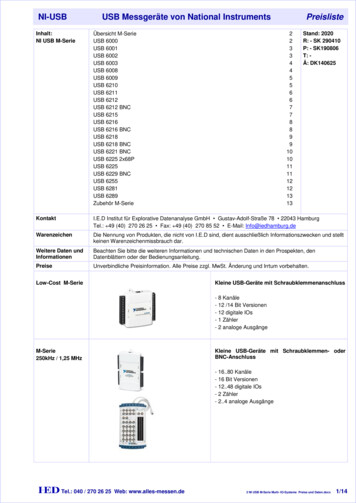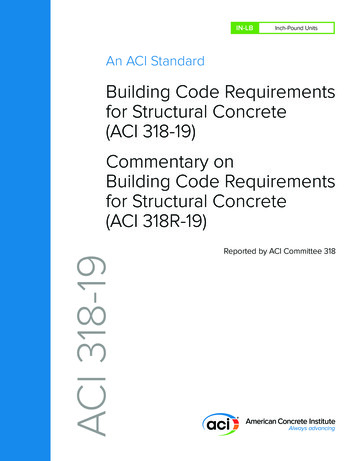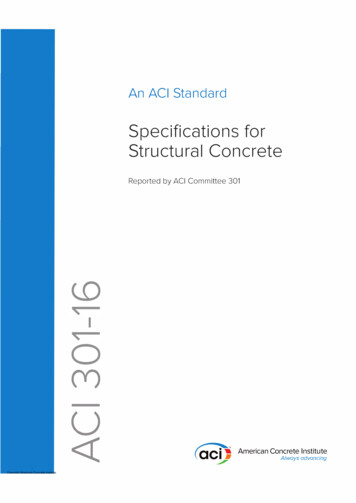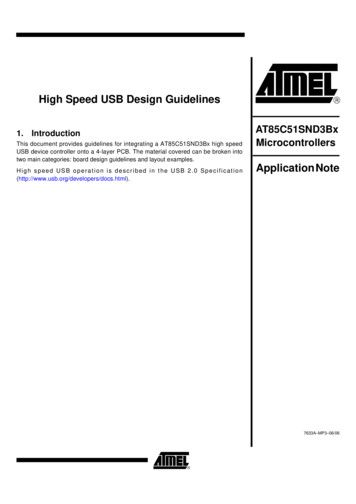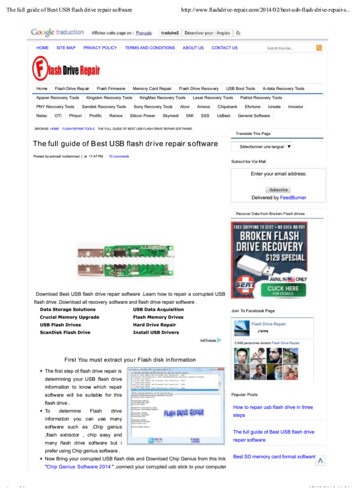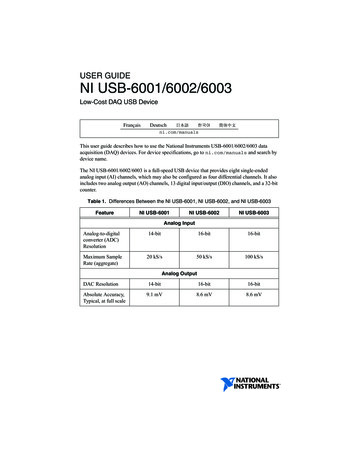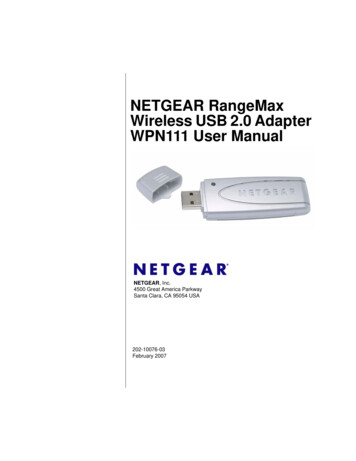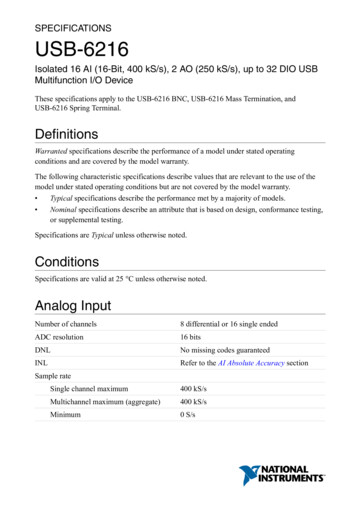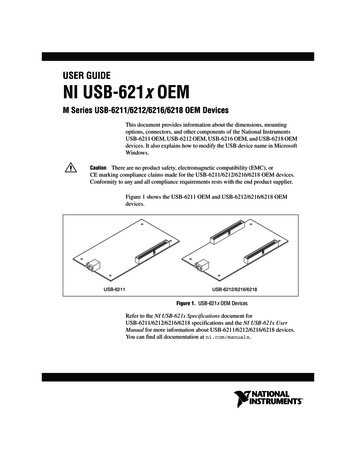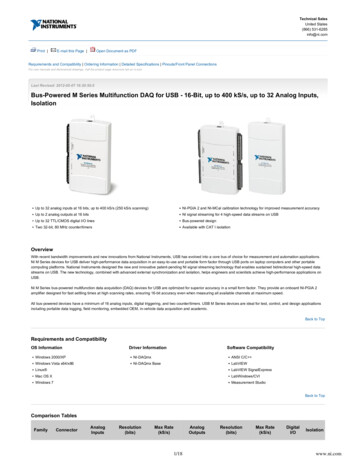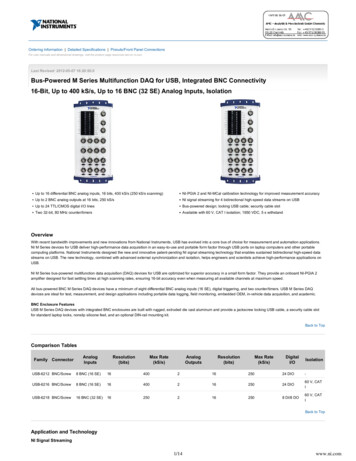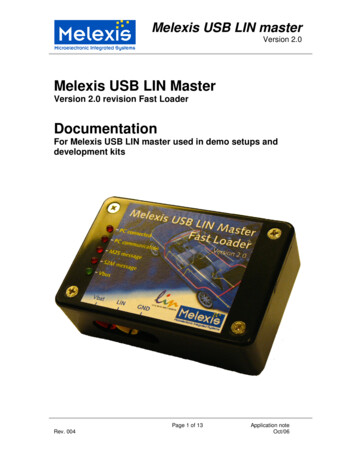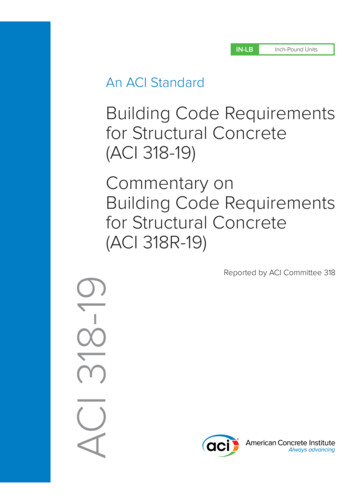
Transcription
IN-LBInch-Pound UnitsAn ACI StandardBuilding Code Requirementsfor Structural Concrete(ACI 318-19)ACI 318-19Commentary onBuilding Code Requirementsfor Structural Concrete(ACI 318R-19)Reported by ACI Committee 318
Building Code Requirements forStructural Concrete (ACI 318-19)An ACI StandardCommentary on Building Code Requirements forStructural Concrete (ACI 318R-19)Reported by ACI Committee 318Jack P. Moehle, ChairGregory M. Zeisler, Secretary (Non-voting)VOTING MEMBERSNeal S. AndersonRoger J. BeckerJohn F. BonacciDean A. BrowningJoAnn P. BrowningJames R. CagleyNed M. ClelandCharles W. DolanCatherine E. FrenchRobert J. FroschLuis E. GarciaSatyendra GhoshJames R. HarrisTerence C. HollandJames O. JirsaDominic J. KellyGary J. KleinRonald KlemencicWilliam M. KlormanMichael E. KregerTheresa M. AhlbornF. Michael BartlettAsit N. BaxiAbdeldjelil BelarbiAllan P. BommerSergio F. BrenaJared E. BreweNicholas J. CarinoMin Yuan ChengRonald A. CookDavid DarwinCurtis L. Decker-H൵UH\ - 'UDJRYLFKJason L. DraperLisa R. FeldmanDamon R. FickDavid C. FieldsAnthony E. FioratoRudolph P. FrizziWassim M. GhannoumHarry A. GleichZen HodaR. Brett HollandR. Doug HootonKenneth C. HoverI-chi HuangMatias HubeMary Beth D. HuesteJose M. Izquierdo-EncarnacionMaria G. JuengerKeith E. KesnerInsung KimDonald P. KlineJason J. KrohnRaul D. Bertero*Mario Alberto ChiorinoJuan Francisco Correal Daza*Kenneth J. Elwood*Luis B. Fargier-GabaldonWerner A. F. Fuchs*Patricio Garcia*Raymond Ian GilbertWael Mohammed HassanAngel E. HerreraColin L. LoboRaymond LuiPaul F. MlakarMichael C. MotaLawrence C. NovakCarlos E. OspinaGustavo J. Parra-MontesinosRandall W. PostonCarin L. Roberts-WollmannMario E. RodriguezDavid H. Sanders7KRPDV & 6FKDH൵HUStephen J. SeguirantAndrew W. TaylorJohn W. WallaceJames K. WightSharon L. WoodLoring A. Wyllie Jr.Fernando YanezSUBCOMMITTEE MEMBERSDaniel A. KuchmaJames M. LaFaveAndres LepageRemy D. LequesneRicardo R. LopezLaura N. LowesFrank Stephen MalitsLeonardo M. MassoneSteven L. McCabeIan S. McFarlaneRobert R. McGlohnDonald F. MeinheitFred MeyerDaniel T. MullinsClay J. NaitoWilliam H. OliverViral B. PatelConrad PaulsonJose A. PincheiraMehran PourzanjaniSantiago PujolJose I. RestrepoNicolas RodriguesAndrea J. SchokkerBahram M. ShahroozJohn F. SilvaLesley H. SneedJohn F. StantonBruce A. SuprenantMiroslav VejvodaW. Jason WeissChristopher D. WhiteLIAISON MEMBERSAugusto H. Holmberg*Hector Monzon-DespangErnesto NgGuney OzcebeEnrique Pasquel*Guillermo Santana*Ahmed B. ShuraimRoberto Stark*Julio TimermanRoman Wan-Wendner*Liaison members serving on various subcommittees.CONSULTING MEMBERSDavid P. GustafsonNeil M. HawkinsRobert F. MastBasile G. RabbatACI 318-19 supersedes ACI 318-14, was adopted May 3, 2019, and published June2019.Copyright 2019, American Concrete Institute.David M. RogowskyAll rights reserved including rights of reproduction and use in any form or by anymeans, including the making of copies by any photo process, or by electronic ormechanical device, printed, written, or oral, or recording for sound or visual reproduction or for use in any knowledge or retrieval system or device, unless permission inwriting is obtained from the copyright proprietors.
First printing: June 2019ISBN: 978-1-64195-056-5DOI: 10.14359/51716937Building Code Requirements for Structural Concrete and CommentaryCopyright by the American Concrete Institute, Farmington Hills, MI. All rights reserved. This materialmay not be reproduced or copied, in whole or part, in any printed, mechanical, electronic, film, or otherdistribution and storage media, without the written consent of ACI.The technical committees responsible for ACI committee reports and standards strive to avoidambiguities, omissions, and errors in these documents. In spite of these efforts, the users of ACIdocuments occasionally find information or requirements that may be subject to more than oneinterpretation or may be incomplete or incorrect. Users who have suggestions for the improvement ofACI documents are requested to contact ACI via the errata website at px. Proper use of this document includes periodically checking for errata for the mostup-to-date revisions.ACI committee documents are intended for the use of individuals who are competent to evaluate thesignificance and limitations of its content and recommendations and who will accept responsibility forthe application of the material it contains. Individuals who use this publication in any way assume allrisk and accept total responsibility for the application and use of this information.All information in this publication is provided “as is” without warranty of any kind, either express orimplied, including but not limited to, the implied warranties of merchantability, fitness for a particularpurpose or non-infringement.ACI and its members disclaim liability for damages of any kind, including any special, indirect, incidental,or consequential damages, including without limitation, lost revenues or lost profits, which may resultfrom the use of this publication.It is the responsibility of the user of this document to establish health and safety practices appropriateto the specific circumstances involved with its use. ACI does not make any representations with regardto health and safety issues and the use of this document. The user must determine the applicability ofall regulatory limitations before applying the document and must comply with all applicable laws andregulations, including but not limited to, United States Occupational Safety and Health Administration(OSHA) health and safety standards.Participation by governmental representatives in the work of the American Concrete Institute and inthe development of Institute standards does not constitute governmental endorsement of ACI or thestandards that it develops.Order information: ACI documents are available in print, by download, through electronic subscription,or reprint, and may be obtained by contacting ACI.ACI codes, specifications, and practices are made available in the ACI Collection of Concrete Codes,Specifications, and Practices. The online subscription to the ACI Collection is always updated, andincludes current and historical versions of ACI’s codes and specifications (in both inch-pound and SIunits) plus new titles as they are published. The ACI Collection is also available as an eight-volume set ofbooks and a USB drive.American Concrete Institute38800 Country Club DriveFarmington Hills, MI 48331Phone: 1.248.848.3700Fax: 1.248.848.3701www.concrete.orgAmerican Concrete Institute – Copyrighted Material – www.concrete.org
ACI 318-19: BUILDING CODE REQUIREMENTS FOR STRUCTURAL CONCRETE3PREFACE TO ACI 318-19The “Building Code Requirements for Structural Concrete” (“Code”) provides minimum requirements for the materials,design, and detailing of structural concrete buildings and, where applicable, nonbuilding structures. This Code was developedby an ANSI-approved consensus process and addresses structural systems, members, and connections, including cast-in-place,precast, shotcrete, plain, nonprestressed, prestressed, and composite construction. Among the subjects covered are: design andconstruction for strength, serviceability, and durability; load combinations, load factors, and strength reduction factors; strucWXUDO DQDO\VLV PHWKRGV GHÀHFWLRQ OLPLWV PHFKDQLFDO DQG DGKHVLYH DQFKRULQJ WR FRQFUHWH GHYHORSPHQW DQG VSOLFLQJ RI UHLQIRUFHPHQW FRQVWUXFWLRQ GRFXPHQW LQIRUPDWLRQ ¿HOG LQVSHFWLRQ DQG WHVWLQJ DQG PHWKRGV WR HYDOXDWH WKH VWUHQJWK RI H[LVWLQJ structures.The Code was substantially reorganized and reformatted in 2014, and this Code continues and expands that same organizational philosophy. The principal objectives of the reorganization were to present all design and detailing requirements forstructural systems or for individual members in chapters devoted to those individual subjects, and to arrange the chapters ina manner that generally follows the process and chronology of design and construction. Information and procedures that arecommon to the design of multiple members are located in utility chapters. Additional enhancements implemented in this CodeWR SURYLGH JUHDWHU FODULW\ DQG HDVH RI XVH LQFOXGH WKH ¿UVW XVH RI FRORU LOOXVWUDWLRQV DQG WKH XVH RI FRORU WR KHOS WKH XVHU QDYLJDWH WKH &RGH DQG TXLFNO\ ¿QG WKH LQIRUPDWLRQ WKH\ QHHG 6SHFLDO WKDQNV WR %HQWOH\ 6\VWHPV ,QFRUSRUDWHG IRU XVH RI WKHLU 3UR&RQFUHWH VRIWZDUH WR SURGXFH PDQ\ RI WKH ¿JXUHV IRXQG LQ WKH &RPPHQWDU\ Uses of the Code include adoption by reference in a general building code, and earlier editions have been widely used inthis manner. The Code is written in a format that allows such reference without change to its language. Therefore, backgrounddetails or suggestions for carrying out the requirements or intent of the Code provisions cannot be included within the Codeitself. The Commentary is provided for this purpose.Some considerations of the committee in developing the Code are discussed in the Commentary, with emphasis given tothe explanation of new or revised provisions. Much of the research data referenced in preparing the Code is cited for the userdesiring to study individual questions in greater detail. Other documents that provide suggestions for carrying out the requirements of the Code are also cited.Technical changes from ACI 318-14 to ACI 318-19 are outlined in the August 2019 issue of Concrete International and aremarked in the text of this Code with change bars in the margins.KEYWORDSadmixtures; aggregates; anchorage (structural); beam-column frame; beams (supports); caissons; cements; cold weather;columns (supports); combined stress; composite construction (concrete to concrete); compressive strength; concrete; construction documents; construction joints; continuity (structural); contraction joints; cover; curing; deep beams; deep foundations;GHÀHFWLRQV GULOOHG SLHUV HDUWKTXDNH UHVLVWDQW VWUXFWXUHV ÀH[XUDO VWUHQJWK ÀRRUV IRRWLQJV IRUPZRUN FRQVWUXFWLRQ KRW weather; inspection; isolation joints; joints (junctions); joists; lightweight concretes; load tests (structural); loads (forces);mixture proportioning; modulus of elasticity; moments; piles; placing; plain concrete; precast concrete; prestressed concrete;prestressing steels; quality control; reinforced concrete; reinforcing steels; roofs; serviceability; shear strength; shotcrete; spans;splicing; strength analysis; stresses; structural analysis; structural design; structural integrity; structural walls; T-beams; torsion;walls; water; welded wire reinforcement.American Concrete Institute – Copyrighted Material – www.concrete.org
4ACI 318-19: BUILDING CODE REQUIREMENTS FOR STRUCTURAL CONCRETEINTRODUCTIONACI 318-19, “Building Code Requirements for StructuralConcrete,” hereinafter called the Code or the 2019 Code,and ACI 318R-19, “Commentary,” are presented in a sideby-side column format. These are two separate but coordinated documents, with Code text placed in the left columnand the corresponding Commentary text aligned in the rightcolumn. Commentary section numbers are preceded by an“R” to further distinguish them from Code section numbers.The two documents are bound together solely for the user’sconvenience. Each document carries a separate enforceableand distinct copyright.As the name implies, “Building Code Requirements forStructural Concrete” is meant to be used as part of a legallyDGRSWHG EXLOGLQJ FRGH DQG DV VXFK PXVW GL൵HU LQ IRUP DQG VXEVWDQFH IURP GRFXPHQWV WKDW SURYLGH GHWDLOHG VSHFL¿FDtions, recommended practice, complete design procedures,or design aids.The Code is intended to cover all buildings of the usualtypes, both large and small. Requirements more stringentthan the Code provisions may be desirable for unusualconstruction. The Code and Commentary cannot replacesound engineering knowledge, experience, and judgment.A building code states only the minimum requirementsnecessary to provide for public health and safety. The Codeis based on this principle. For any structure, the owner orthe licensed design professional may require the quality ofmaterials and construction to be higher than the minimumrequirements necessary to protect the public as stated in theCode. However, lower standards are not permitted.The Code has no legal status unless it is adopted by thegovernment bodies having the police power to regulatebuilding design and construction. Where the Code has notbeen adopted, it may serve as a reference to good practiceeven though it has no legal status.The Code and Commentary are not intended for usein settling disputes between the owner, engineer, architect, contractor, or their agents, subcontractors, materialsuppliers, or testing agencies. Therefore, the Code cannotGH¿QH WKH FRQWUDFW UHVSRQVLELOLW\ RI HDFK RI WKH SDUWLHV LQ usual construction. General references requiring complianceZLWK WKH &RGH LQ WKH SURMHFW VSHFL¿FDWLRQV VKRXOG EH DYRLGHG because the contractor is rarely in a position to acceptresponsibility for design details or construction requirements that depend on a detailed knowledge of the design.Design-build construction contractors, however, typicallycombine the design and construction responsibility. Generally, the contract documents should contain all of the necessary requirements to ensure compliance with the Code. InSDUW WKLV FDQ EH DFFRPSOLVKHG E\ UHIHUHQFH WR VSHFL¿F &RGH VHFWLRQV LQ WKH SURMHFW VSHFL¿FDWLRQV 2WKHU &, SXEOLFDWLRQV VXFK DV ³6SHFL¿FDWLRQV IRU 6WUXFWXUDO &RQFUHWH &, DUH ZULWWHQ VSHFL¿FDOO\ IRU XVH DV FRQWUDFW GRFXPHQWV for construction.The Commentary discusses some of the considerations ofCommittee 318 in developing the provisions contained in theCode. Emphasis is given to the explanation of new or revisedprovisions that may be unfamiliar to Code users. In addition,comments are included for some items contained in previouseditions of the Code to make the present Commentary ind
includes current and historical versions of ACI’s codes and specifications (in both inch-pound and SI units) plus new titles as they are published. The ACI Collection is also available as an eight-volume set of books and a USB drive. American Concrete Institute 38800 Country Club Drive Farmington Hills, MI 48331 Phone: 1.248.848.3700
